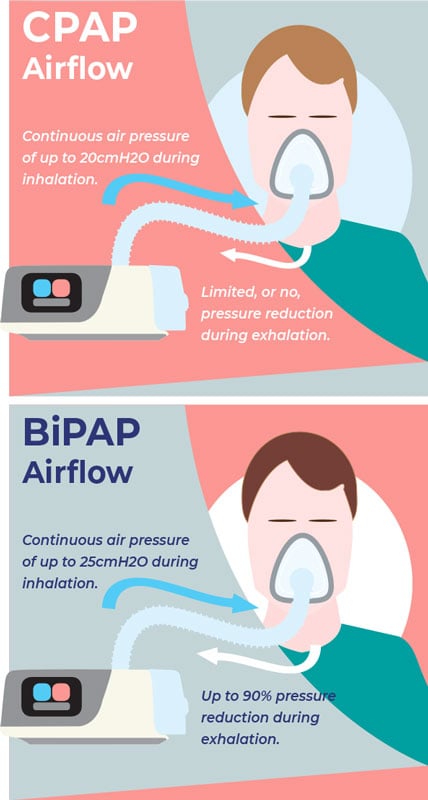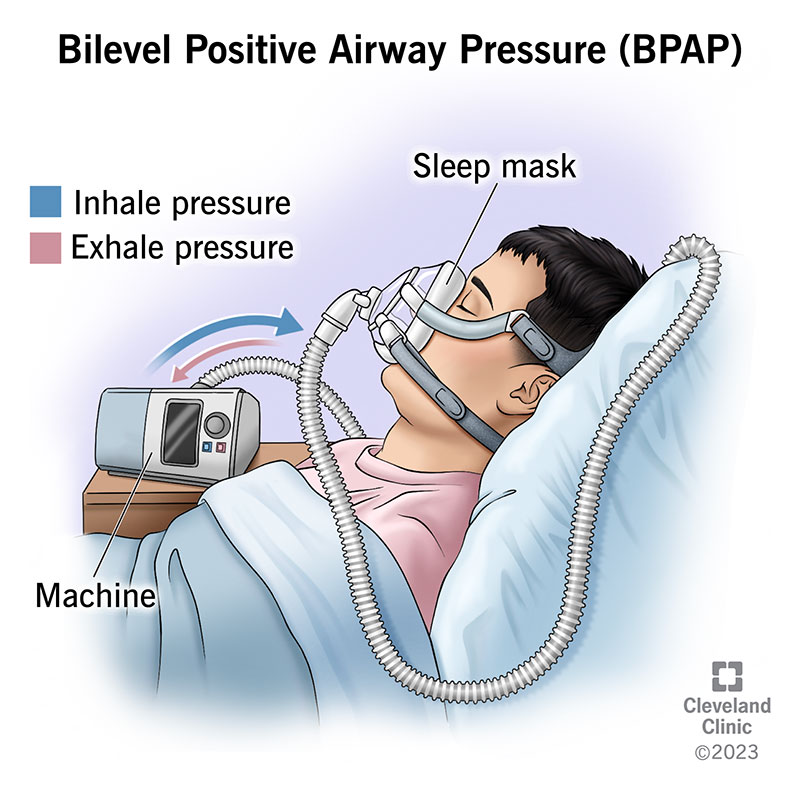Bipap vs. CPAP: Which Is the most effective for Your Rest Problem?
When navigating the complexities of rest problems, the selection in between BiPAP and CPAP treatment is a crucial consideration. Each modality offers distinct benefits tailored to particular conditions, yet the choice depends upon private client demands and comfort degrees. While CPAP provides a consistent air flow suitable for obstructive sleep apnea, BiPAP's dual stress settings may boost convenience for those with even more elaborate respiratory concerns. Understanding these differences can significantly impact treatment efficacy, leaving one to contemplate which alternative absolutely aligns with their health needs and way of life.
Understanding Sleep Disorders
Rest conditions incorporate a variety of conditions that interrupt normal rest patterns, affecting both the top quality and duration of remainder. These disorders can materialize in various types, consisting of insomnia, rest apnea, narcolepsy, agitated leg syndrome, and parasomnias. Each problem presents one-of-a-kind obstacles, typically resulting in substantial daytime fatigue, cognitive impairment, and emotional disruptions.
Sleeping disorders is identified by trouble falling or remaining asleep, while rest apnea involves duplicated disturbances in breathing during sleep, usually resulting in fragmented remainder. Narcolepsy, on the various other hand, is noted by excessive daytime sleepiness and unexpected rest strikes. Restless leg syndrome causes uneasy experiences in the legs, motivating an uncontrollable desire to relocate them, which can additionally prevent the capacity to sleep.
The impact of sleep disorders prolongs past specific wellness, influencing general efficiency, partnerships, and lifestyle. Recognizing the details nature of each problem is essential for efficient diagnosis and treatment. As sleep health becomes increasingly recognized as an important component of overall well-being, dealing with these disorders is important for boosting both rest top quality and day-to-day performance.
Exactly How CPAP Works
Continuous Positive Respiratory Tract Stress (CPAP) treatment is frequently employed as a primary treatment for obstructive sleep apnea (OSA) The device of CPAP involves making use of a maker that provides a stable stream of air through a mask put on throughout sleep. This airflow keeps favorable pressure in the respiratory tract, avoiding the collapse or blockage of the throat that can happen during rest.
When a client inhales, the CPAP equipment supplies a continuous circulation of air, making certain that the air passage remains open - BiPAP Rental. This not just eases the signs of OSA, such as snoring and disrupted rest patterns, but additionally minimizes the involved wellness dangers, consisting of cardio complications and daytime exhaustion
The stress settings on a CPAP equipment can be tailored to fulfill private client needs, commonly identified via a sleep research. Generally, CPAP treatment has actually been revealed to substantially boost the top quality of sleep and general wellness for people enduring from obstructive rest apnea.
How BiPAP Works
BiPAP, or Bilevel Positive Air Passage Pressure, is a specific type of non-invasive ventilation that is especially valuable for patients with conditions such as complex sleep apnea or respiratory disorders. Unlike CPAP, which delivers a continuous stream of air at a single pressure, BiPAP provides two distinctive stress setups: a greater inspiratory stress for inhalation and a lower expiratory pressure for exhalation. This dual-pressure approach allows for easier breathing, decreasing the effort required throughout exhalation.
The tool runs with a mask fitted over the nose or mouth, connected to a device that generates air pressure. When the patient breathes in, the equipment provides the higher pressure to use this link aid with air movement, making sure that the air passage stays open. Upon exhalation, the machine automatically lowers the stress, making it much more comfortable for the individual to take a breath out.

Key Differences Between BiPAP and CPAP

In comparison, BiPAP (Bilevel Positive Respiratory tract Pressure) supplies two different stress setups: one for inhalation and a lower one for exhalation. This double Click This Link stress system enables more comfy breathing, specifically for clients who have a hard time with breathing out versus a continuous pressure. BiPAP is usually recommended for individuals with intricate rest apnea, chronic obstructive pulmonary illness (COPD), or those that call for additional support during sleep.
In addition, the complexity of BiPAP devices usually causes a greater price and requires much more cautious titration than CPAP. BiPAP Rental. Recognizing these vital distinctions can aid in acknowledging which gadget may be preferable for details rest disorders, establishing the foundation for enlightened therapy decisions
Choosing the Right Treatment
Just how can one establish one of the most ideal treatment for taking care of rest conditions? The decision between BiPAP and CPAP therapy primarily rests on the specific features of the rest problem, the individual's general health and wellness, and their comfort with over at this website the tool. CPAP, which supplies a constant stream of air, is typically recommended for obstructive sleep apnea (OSA) It maintains an open air passage throughout rest, successfully avoiding hypopneas and apneas.
Alternatively, BiPAP supplies two degrees of stress: one for inhalation and a reduced one for exhalation. This dual stress system is valuable for individuals with complex rest apnea or those who experience problem exhaling versus a continuous stress. Additionally, BiPAP is commonly suggested for people with breathing problems, such as chronic obstructive lung disease (COPD), where varying stress settings can boost comfort and conformity.
Ultimately, a comprehensive analysis by a sleep professional, including a rest research, can assist determine which treatment lines up best with the individual's needs. Aspects such as comfort, convenience of use, and details clinical conditions ought to likewise be thought about to optimize therapy outcomes.
Conclusion
In recap, both BiPAP and CPAP serve unique functions in the management of rest disorders. CPAP is effective for obstructive rest apnea through consistent airflow, while BiPAP provides twin stress settings that boost convenience for those with intricate sleep apnea or respiratory system problems. The choice in between these treatments need to be guided by individual demands and problems, demanding a comprehensive evaluation by a sleep specialist to make certain optimum therapy results and enhanced high quality of sleep.

Overall, CPAP therapy has actually been revealed to significantly enhance the top quality of rest and overall health and wellness for people enduring from obstructive sleep apnea.
BiPAP is typically advised for people with complex sleep apnea, chronic obstructive lung condition (COPD), or those that call for additional support during rest.
CPAP is reliable for obstructive sleep apnea via consistent air movement, while BiPAP provides twin stress setups that boost convenience for those with intricate rest apnea or respiratory issues.